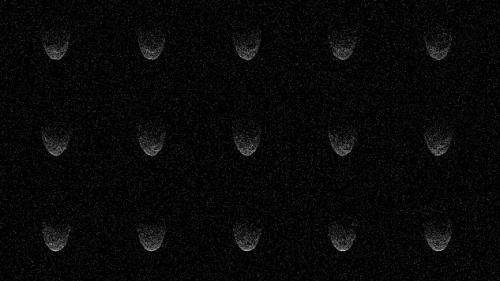What can radar images of a fast-moving asteroid tell us? Plenty, thanks to the combined efforts of two world-class radio telescopes. This series of images was created when Arecibo in Puerto Rico bounced a radar signal off the asteroid 2006 SX 217. The echo of that signal was then received and decoded by the Green Bank Telescope in West Virginia. Once analyzed, these images will be used to construct a 3D model of this asteroid to learn more about its origin and composition. Credit: Ellen Howell (NAIC), Arecibo, NRAO/AUI/NSF
Like a pinch-hitter driving in the game-winning run, the National Science Foundation's Green Bank Telescope (GBT) stepped up to the plate to help astronomers at the Arecibo Observatory study and image a rapidly fleeing asteroid before it sailed beyond view. The tag-team observation was accomplished with Arecibo's powerful transmitter first sending radar pulses at the asteroid known as 2006 SX 217 and the Green Bank Telescope's sensitive receivers later capturing the echo.
Based on previous observations in 2006, astronomers calculated that for four days (April 20-24, 2014) the asteroid would be close enough to Earth for Arecibo to conduct radar observations. Radar studies, in this case, were essential since the asteroid was headed away from Earth into the glare of the Sun, blinding optical telescopes.
This observing technique, known as bi-static radar, has been used successfully to study other asteroids, the inner planets, Earth's Moon and other moons in our Solar System.
Due to a minor technical glitch, however, the needed receiver on Arecibo was unavailable during the crucial time when conditions at the telescope would have been ideal. Fortunately, the GBT, which is the world's largest fully steerable radio telescope, was available to step in on April 23 to receive the echoes from the signal beamed by Arecibo.
At the time of the observations, the asteroid was 4.8 million kilometers (3 million miles) from Earth, which is more than ten times the distance from the Earth to the Moon. The team's initial observations showed that the object is unusually dark and may be as large as 1200 meters (4000 feet) in diameter, which is larger than previous estimates. "This asteroid is really big and its surface is probably about as black as the toner in a copier," said Ellen Howell, an astronomer at the Arecibo Observatory who led the observation. "It's also slowly rotating, with one side moving toward Earth and the other away."
Because the asteroid is spinning, astronomer can study how the radar signal is spread out and then—after careful analysis—construct a 3D model of it. Since 2006 SX 217 won't be in range again until 2066, this observation was a very high priority.
The observing team at Arecibo thanks GBT Director Karen O'Neil and National Radio Astronomy Observatory astronomer Frank Ghigo.
Provided by National Radio Astronomy Observatory























